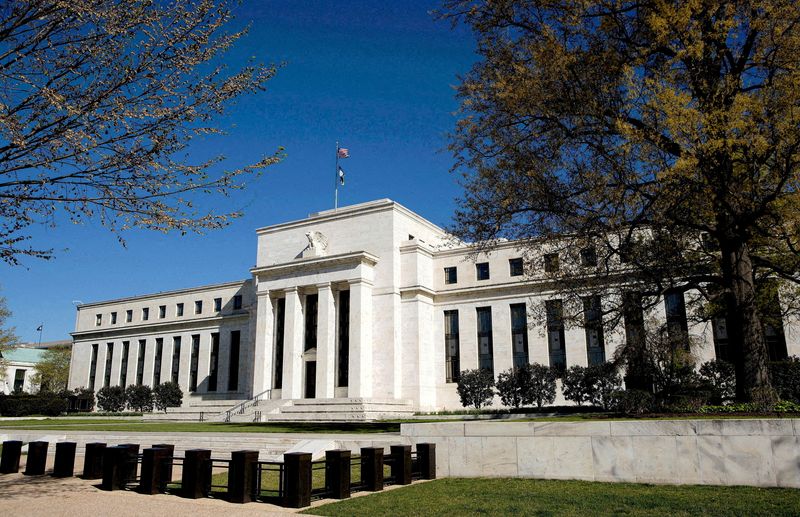In the Market: Fed may struggle to rid backstops of stigma amid new push

By Paritosh Bansal
(Reuters) – The U.S. Federal Reserve is encouraging banks to count on its long-shunned cash backstops in a bid to support its monetary policy and financial stability goals. Its latest efforts may not move the dial much.
The Fed’s discount window and the Standing Repo Facility (SRF) are credit backstops where lenders can get cash against collateral such as Treasury bonds. They can also double as monetary policy tools, helping to keep interest rates close to the Fed’s policy rate. But banks have been reluctant to use them, as it can signal they are under stress.
In its latest effort to get past these issues, the Fed in August told banks it was OK to count on its backstops as sources of cash in internal liquidity stress tests, exercises that large banks have to do regularly to prove to their examiners that they can quickly get cash when needed. Last month, Michael Barr, the Fed’s regulatory chief, underscored that message, saying liquidity regulations are “supportive of market functioning and the smooth implementation of monetary policy.”
Over the past few weeks, I have been asking banking industry experts how effective the Fed’s move might be in achieving those goals. Their overall take: While getting more banks ready to use the Fed facilities would bolster financial stability, it will be hard to get rid of the stigma and may not do much for monetary policy.
“Stigma has been around since the 20s. It’s a complicated and significant problem that will require a lot of effort to address,” said Bill Nelson, chief economist at the think-tank Bank Policy Institute.
A senior executive at a large bank who requested anonymity to speak candidly said there’s still a difference between what a policy maker wants and what a supervisor will want. “If you were to ever, for whatever reason, access the discount window,” the executive said, “the first call is going to be from your supervisor asking, ‘What’s going on?’”
POLICY IMPACT
The other intended impact of the Fed’s moves – helping with its monetary policy objectives — may also be frustrated. One hope behind the move is that allowing banks to rely to some extent on the backstops for liquidity would reduce their demand for reserves, or cash that they park at the central bank.
Currently, banks rely heavily on reserves to meet contingent funding requirements in the internal liquidity stress tests. With the Fed’s August clarification, other easily tradable assets such as Treasury securities could become substitutes.
If it works as theorized, it could give the Fed more room for quantitative tightening. That’s because the financial system needs a certain level of reserves to function smoothly, and as the Fed shrinks its balance sheet, it takes out reserves.
This would be a good time for the plan to work. SRF, which has largely been lying dormant, saw a surge in usage at the of the third quarter, the highest since it was set up in 2021. SRF usage has been one of the indicators the Fed has been watching as it looks for signs that liquidity is getting tighter in the financial system.
The bank executive said the Fed’s clarification is unlikely to make a perceptible difference, however. That’s because the largest banks also have other liquidity tests, where they cannot count on the Fed backstops.
The banker pointed to the liquidity coverage ratio, which requires that large banks have enough high-quality liquid assets — or assets such as Treasuries that can be easily traded — to meet their cash needs in times of stress.
Barr also said in his speech he wants to propose additional changes to liquidity regulations, some of which could lead banks to lower their holdings of Treasuries, the bank executive said.
BIG PUSH
Where bank regulators have made a bigger dent so far is in addressing financial stability issues. They have been making a concerted push since the bank collapses of March 2023 to get more banks at least ready to use the backstops should they ever need it. Silicon Valley Bank failed in part because it hadn’t done the groundwork needed to borrow from the discount window, leading to delays that proved to be fatal.
Barr noted in his speech that since that time, more than $1 trillion in additional collateral had been pledged to the discount window and more banks had signed up for the SRF.
BPI’s Nelson said liquidity risk is the result of a market failure. “That’s something that happens when an institution is solvent and has assets that are worth more than its liabilities, but it’s just not able to convert them into liquidity fast enough at low enough cost,” Nelson said. “And in that sense, borrowing from the discount window solves the market failure.”
But another bank regulation expert said the central bank’s focus on normalizing discount window access after the March 2023 failures is misplaced, calling instead for greater focus on addressing interest rate risk.
“I don’t believe that discount window stigma is what caused those institutions to fail,” said Jill Cetina, a former Dallas Fed official who is now a finance professor at Texas A&M University. “What caused them to fail was the fact that they had excessive levels of interest rate risk and were illiquid.”







